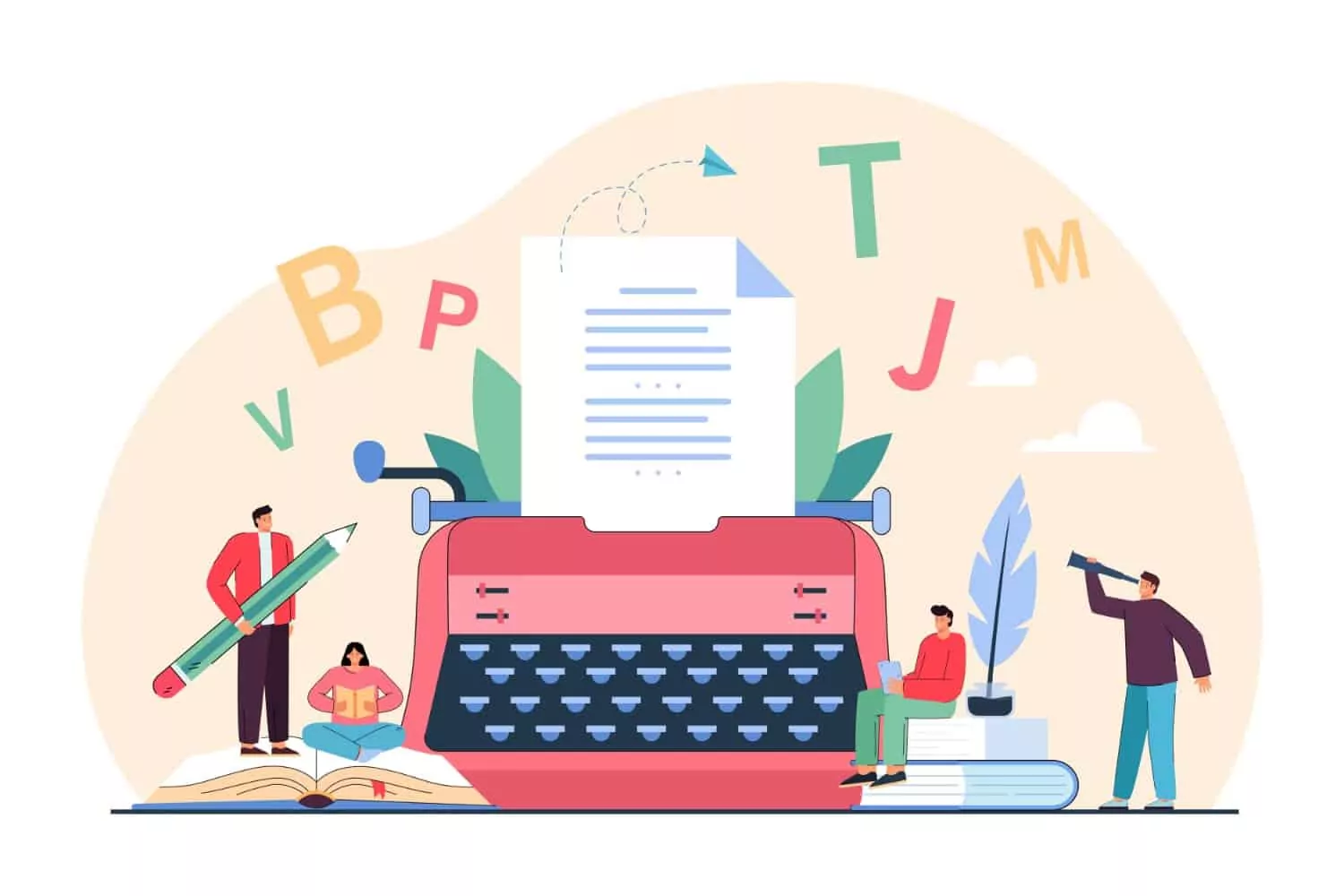
Top 20 Literary Terms Everyone Should Know
Table of Contents
Literary terms are one of the many techniques a writer uses to enhance the quality of their writing style, structure, or overall impression. They can be used playfully to crack us up, in a humorous way to employ sarcasm or coin new words or phrases.
Reading a book allows you to learn about the author’s thoughts through what they wrote. Authors employ various literary devices to shape their writing and demonstrate what they are attempting to say to the reader. Examples include allusions, symbols, foreshadowing, and dramatic irony. Authors also use dream sequences to show their characters’ thoughts but do not say them aloud. Literary devices are used in writing to assist both the author and the reader in better understanding the work.
The Most Common Literary Terms You Should Be Familiar With
Allusions are indirect references to people, places, events, or works of art. They help readers understand what the author is trying to say about a certain idea or concept. For example, when Shakespeare refers to “the spring” in his poem “Love’s Labor’s Lost,” he alludes to the season without naming it. When he talks about a season in this manner, the audience understands he’s referring to a specific time of year without him having to say so.
Authors frequently use symbols to represent people, places, or ideas. Characters can be subtle. In several of his works, Ernest Hemingway, for example, uses icebergs as symbols. In these examples, icebergs represent coldness, cruelty, and death, all of which are characteristics of the characters represented by the symbols. Symbolism, like allusions, helps writers make their ideas more precise while conveying them to their readers.
Another technique used by writers is dramatic irony. This happens when an author says something that his characters don’t know but the audience does. One example is when Sherlock Holmes tells Dr. Watson what Watson already knows: Holmes is the perpetrator of a series of murders that the two have been investigating together.
In this way, dramatic irony helps in the creation of tension in writing. It provides the audience with a sense of satisfaction when they discover something the characters are unaware of.
Another standard literary device that allows authors to use symbols and images to show what a character is thinking and feeling on the inside is a dream sequence. People frequently meet things in their dreams that represent how they are feeling.
For example, suppose a character has recently lost someone close to them. In that case, they may dream of gravestones or other images of death to express their grief. Authors can connect with their readers more deeply with dream sequences than with most other types of writing. Now that we have grasped the general idea, let’s move on to each literary device out of the 20 we are featuring:
Literary Terms: Allegory
An allegory is a story that uses symbols to convey a meaning that is not explicitly stated in the narrative. Allegory, which includes fables, parables, and apologetics, can have multiple meanings that the reader must interpret.
George Orwell’s Animal Farm is one of the best-known allegories. Animal Farm appears to be a story about farm animals revolting against their farmer. The real story, however, is about Orwell’s dissatisfaction with the Bolshevik Revolution, and it is an attack on the Russian government.
Literary Terms: Alliteration
Alliteration uses the same sound at the beginning of a series of words to create an audible pulse that gives a piece of writing a lulling, lyrical, and/or passionate effect. For example, Peter Piper picked a peck of pickled peppers. Sally sells seashells by the seashore. How much wood could a woodchuck chuck if a woodchuck could chuck wood?

Literary Terms: Allusion
Allusions are generally defined as brief but purposeful references to a person, place, event, or another work of literature within a literary text. When we make an allusion, we expect the other person to understand what we’re referring to. Chocolate, for example, is his kryptonite. In this case, the word “kryptonite” refers to the superhero Superman.
Literary Terms: Colloquialism
Colloquialism is the informal, everyday language of a specific geographical region. For example, “soccer” is a colloquial term in the United States for “football,” which is a colloquial term in the United Kingdom. This includes words (such as “y’all,” “going to,” or “want to”), phrases (such as “old as the hills” and “graveyard dead”), or even entire aphorisms.
“There’s more than one way to skin a cat” and “He needs to step up to the plate” are examples of informal colloquialisms.
Literary Terms: Satire & Irony
Satire and irony are two concepts that are closely related, but there is a distinction between them. The irony is a literary device created by deliberately using language diametrically opposed to the truth. Satire uses humour, wit, exaggeration, or irony to expose a social flaw. Irony contrasts the surface of things and how they are. Literary satire falls into three types:
- Dramatic (when the reader knows what is going to happen before the characters),
- Situational (when the reader expects a particular outcome only to be surprised by the turn of events), and
- Verbal (when the statement The intended meaning is the opposite of what is said).
Literary Terms: Symbolism
Symbolism can be found in many different kinds of writing and art. It has a lot to do with how we feel and think inside. Most people know how to use symbols in their daily lives. Symbolism in poetry is when people use characters in their writing.
Most symbolism is based on a direct link between a word or phrase’s literal and symbolic meanings. For example, the line “skulls upon skulls” in poetry refers to the number of skulls. People who like to think about death may think that thinking about past mistakes slows progress.
Symbolism is hardly ever used in modern literature. Authors who were well-known used symbols. They used symbols to talk about things like death and love. Symbolism is the use of signs and symbols in writing.
Because of how popular writing styles that change quickly, like flash fiction and cyberpunk, this use of literary devices has almost died out. Because literature changes so quickly, old writing methods seem old and outdated compared to what new writers can do.
Symbolism is a powerful literary tool that can be used in many places other than classic works of art. Most people know what words like “death” and “love” mean when used as symbols. Most of the time, religious symbols are found in religious works where one person or a small group talks about a part of their faith or relationship with God.

Literary Terms: Diction
Diction refers to the rules and norms of written English. The rules governing diction include syntax, grammar and pronunciation. Essentially, having a good vocabulary helps you express yourself clearly. A word’s meaning is what it refers to something or somebody’s identity or character.
For example, ‘honesty’ means being honest in your dealings, as in ‘John is honest.’ The dictionary aspect of your name refers to your family history- in other words, your lineage or heritage. Comments can also be related to your feelings- for example, ‘sad’ means ‘mournful.’ The definitions you learn at school help you understand what you’re reading and hearing on TV and radio.
Literary Terms: Euphemism
Euphemisms are commonly used to describe something unpleasant. Instead of directly stating what one feels, one uses a less direct word or phrase. For example, people use the term ‘dead-ender’ to describe someone who keeps trying despite failure. A dead-ender is not living; he is a person without hope.
The etymologies of many common words reveal how our ancestors used euphemisms to describe unpleasant situations or feelings. For example, the Greek word for ‘curse’ is katharmós, which has become our word ‘cathartic.’ This word comes from the Greek kathartikos, which means ‘to laugh away.’ In ancient Rome, a laughter potion was supposed to cure you of whatever ailed you.
Today, we still use this as an antonym for ‘catatonic,’ which refers to when a person becomes unresponsive due to illness or mental trauma. Euphemisms have changed over time; they now have vastly different meanings within different cultures.
Literary Terms: Foreshadowing
Foreshadowing is a way for a writer to give a hint about something that will happen later in the story. Foreshadowing usually occurs at the start of a story or chapter, and it helps the reader figure out what will happen next. Foreshadowing can be done in many different ways by the writer.
Literary Terms: Homophone
A homophone is a word that sounds the same but means something different. A homophone’s spelling may also be different. The two terms can have the exact spelling, like “rose,” or different spellings, like “rain,” “reign,” and “rein.”
Literary Terms: Hyperbole
The use of exaggeration as a way to make a point or as a figure of speech is called hyperbole. It is also sometimes called auxesis in rhetoric. Poetry and speeches draw attention, stir strong emotions, and make a strong impression. It’s a figure of speech, so you shouldn’t usually take it literally.
Literary Terms: Idiom
An idiom is a phrase or expression that usually has a meaning that isn’t literal. However, some words can become idioms even though they still mean the same thing in their literal form. The symbolic meaning of an idiom is different from its literal meaning. Idioms are a type of formulaic language.
Literary Terms: Imagery
We use imagery to make pictures based on what we see or hear. The primary source of images for humans is their own minds. Imagery is used in many different ways, from making things to learning. It can be used to say something, tell stories, and show how people feel. It’s also a powerful way to talk to people and get strong responses.
First, most people can use their imagination. Most of us can imagine things based on what we’ve seen or done in the past. This is like how people with epilepsy see things in their minds even though they can’t see them. We can process information and come up with new ideas with the help of our imagination. It’s also a big part of who we are; our minds need images to work right.
Literary Terms: Juxtaposition
Juxtaposition is putting two things next or close to each other. This is often done to compare and contrast two things and show how they are alike or different.
Literary Terms: Malapropism
A malapropism is when someone says something that makes no sense because they used the wrong word instead of a word with a similar sound.
Literary Terms: Metaphor
A metaphor is a figure of speech that describes an object or action in a way that is not literally true but helps explain an idea or make a comparison. A metaphor says that something is the same as something else.
Literary Terms: Onomatopoeia
Onomatopoeia is a Greek word that means the word imitating the sound. Poetry often uses onomatopoeia to create sounds or provide vivid descriptions. For example, let’s say you wanted to describe the sound of rain.
You’d use onomatopoeia like oohs and ahs to portray the rain’s characteristic noise. Some common onomatopoeic words are echo, zoopraxia and bing-bang. All these examples show how creative language can be with onomatopoeia.
Onomatopoeia is sometimes referred to as metaphor, analogy or expression. Basically, onomatopoeia is the act of imitating the sound made by an object. For example, the sound of a roaring river or a crashing wave would be used to describe a raging river or waves crashing into the shoreline.
Emotion can also be expressed through onomatopoeia by creating various sounds. A sad or angry expression can be conveyed by making different noises with the lips and mouth. This is how Shakespeare told characters’ emotions through appropriate lip movements. Some famous indications using onomatopoeia include ‘gosh,’ ‘wow’, and ‘awesome.’
Literary Terms: Personification
Personification is frequently used in literature and other artistic works to give human characteristics to non-human things. It is used to express ideas and feelings more vividly. For example, poets often use personification in love poems. They depict love as having human form and walking on the earth.
In storytelling, using personification makes your audience feel emotions since it makes inanimate objects seem human-like. For example, Shakespeare’s Romeo and Juliet famously featured the title characters making love in what they believed to be the Capulet family tomb.
In doing so, they spoke of Juliet’s “dead cold arms” and the “withering touch” of her corpse. This was intended to convey the intense sadness and shock that both characters experienced after discovering their difficult situation. Allowing readers to feel such emotions is particularly important when crafting engaging narratives.
Personification is a time-honoured literary device that enhances readers’ engagement with an author’s work by bringing their ideas into visceral relief through emotional associations with actual people or animals.
The concept can be applied liberally in any piece of fiction where it supports an author’s intent; additionally, it can also be used non-fictionally to highlight and empathise with elements of real-world life that aren’t typically anthropomorphised by their nature alone.
Literary Terms: Simile
A simile is a way to compare two things directly. Similes are different from other metaphors because they point out how similar two things are by using comparison words like “like,” “as,” “so,” or “than.” Other metaphors make a comparison between two things without using comparison words.
Literary Terms: Oxymoron
oxymoron: a word or group of words that contradicts itself, like “bittersweet” or “plastic glass.” Oxymorons are like paradoxes and antitheses, often used in poetry and other forms of writing.
Literary Terms FAQ:
1. What level is this article aimed at?
This article caters to a general audience, assuming no prior knowledge of literary terms. It aims to make them accessible and understandable for anyone interested in deepening their understanding of literature.
2. Are there any resources for further learning?
Absolutely! The article mentions recommended books and online resources for those who want to dive deeper into specific terms or literary analysis. Additionally, checking out the “Connect to pop culture” section can lead you to various movies, TV shows, and songs that utilize these terms, making learning more interactive.
3. I’m unfamiliar with some of the pop culture references. Will I still understand the terms?
Yes, the explanations focus on clearly defining each literary term with relevant examples, regardless of your familiarity with pop culture references. However, these references can enhance your understanding by providing relatable modern-day applications of the terms.
4. Do I need to know all 20 terms to appreciate literature?
Knowing even a few key terms can significantly enhance your reading experience. This list provides a broad overview, and you can focus on terms that resonate with you or genres you enjoy reading.
5. Are there any other literary terms I should learn?
While this list highlights 20 essential terms, the world of literature is vast! Explore resources like online literary dictionaries, book club discussions, or even podcasts dedicated to literature to discover more terms and deepen your understanding of storytelling techniques.
In summary
There are different methods and techniques any writer might resort to ensure their writing meets the audience’s taste. So we wanted to introduce you to as many techniques/literary terms as possible for you to use in your writings.
Allusions, symbols, foreshadowing, and dramatic irony are literary devices that help both authors and readers understand what’s going on in a piece of writing by showing ideas roundaboutly or making readers feel uncertain or suspenseful. When writing a book or other piece of literature, deciding which literary devices best demonstrate your thoughts will assist you in conveying them to your readers.





Leave a Reply